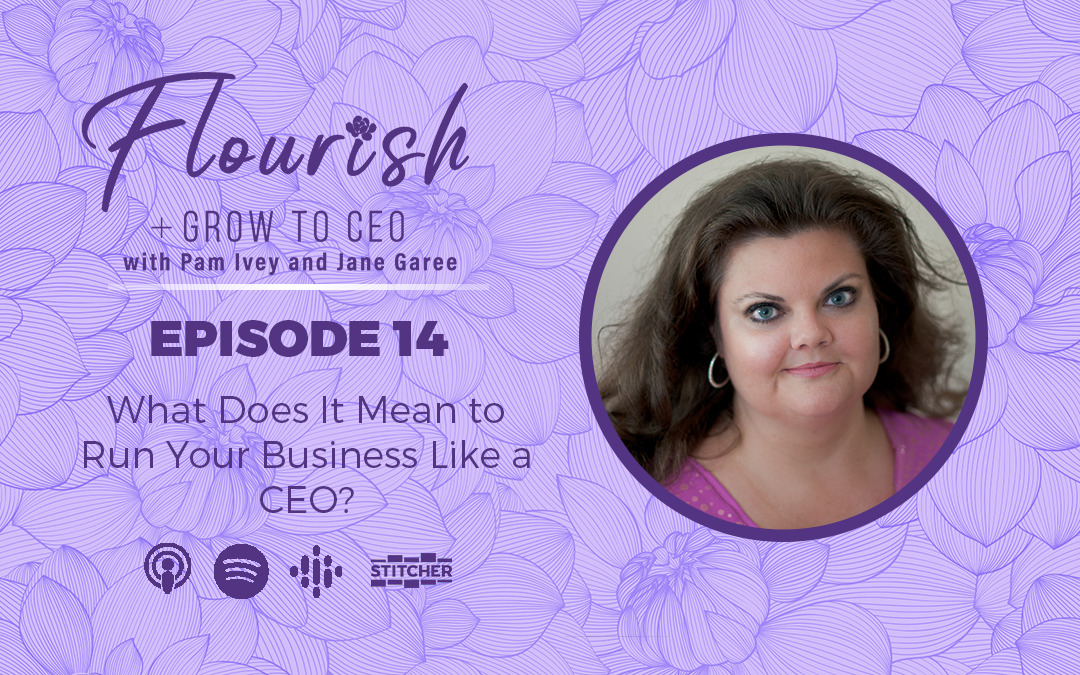Pam (00:00): You’re listening to episode 14 of the Flourish & Grow to CEO Podcast.
Pam (00:26): Are you a lady boss making $50-$100,000 in your business, and you’re ready to break through that 6-figure barrier.
Jane (00:33): Have you done a great job of creating a nice life as the ultimate gig master, but no, your inner CEO is calling you to greater heights? You’re in the right place if you want to create and implement solid fundamentals in your business without sacrificing fun.
Pam (00:48): I’m Pam Ivey, I’m certified in small business management and I concentrate in the areas of training and certifying real estate assistance, coaching and mentoring entrepreneurs in online business, marketing, growth and profit acceleration. And I take men and women business owners aged 40 plus two bucket list destinations around the world for a month at a time to work, explore, and live in community.
Jane (01:14): And I’m Jane Garee, known as the sales strategist for the non-salesperson. And I work with business owners who want to increase their conversion rate, shorten their sales cycle and have more impact and influence with the work they do all while having more fun with selling.
Pam (01:28): Hello everyone. And welcome back to the Flourish & Grow to CEO Podcast. We’re so grateful that you’ve tuned in here and really excited actually that you’re here today because the topic we’re going to talk about when I first heard somebody talk about this, they talked about it in a way that really allowed some light bulbs to kind of go off in my head. I came to some revelations about how to run my business – to really push it forward, you know, move that needle. So we know that many of you in the audience are bringing in an income of between $50 and $99,000 a year. And you’re itching across that 6-figure mark, but haven’t quite figured out the key. Well, this might be it for you. So, we’re talking today about the difference between an entrepreneur or a solopreneur and a CEO. Now we’re not talking about incorporating your business and taking on a board of directors or anything like that.
Pam (02:29): Here, we’re talking about the act of running your business like a CEO. Let’s contrast, shall we? An entrepreneur starts at the beginning and is focused on creating something from nothing. Whereas a CEO is more focused on creating something from something. They grow an existing business into a bigger success. The entrepreneur solopreneur, which I’m going to use interchangeably is more about risk-taking and trying something new. You know, that initial push. Whereas the CEO is more about inertia and growing. An entrepreneur is someone who starts a business and hopes to turn an idea into a profitable business. She’s driven by a vision and can see a product and market fit the CEOs on the other hand, lead strategize and plan. So I have a quote here before I let James speak. I’m always, you know, Ms. Chatterbox, I have a quote here from a girl who calls herself or a woman who calls herself the time queen her name is Matina Pan Moon, and it really sums it up. “Well, a CEO sees every project, every task, every decision as puzzles of a bigger picture, your future. So she treats it more than just its effects on the present, but more importantly, considers its impact on the company vision. On the other hand, a solopreneur just focuses on getting things done.” Do you think that sums it up? Well, Jane, I’m tripping over my tongue today.
Jane (04:18): Yeah. I think that’s a great summation Pam. You know, it’s really interesting coming out of corporate. I have a I have a corporate background, the entrepreneurial skills that are necessary to start a company from nothing into something are very different than the skills of a CEO. Who’s the whole charge is to take whatever is at the moment and either turn it around if the company needs to be turned around or to grow it. And an entrepreneur sometimes does not make for a good CEO. And interestingly enough, sometimes CEOs don’t make good entrepreneurs. The skillset is very different.
Pam (04:59): Yeah, absolutely. Sorry, I’m just nodding away with you here. And I have some kind of descriptors between an entrepreneur and a CEO that I think might be helpful. So an entrepreneur does whatever needs to be done. Cash is King for them and they protect the downside risk. So they’re really output oriented. They do, they do whatever needs to be done. They’re tactical. So they get really into the tactics. They’re focused on the revenue. Of course they really embrace risk because you know, starting our own businesses, there’s a lot of risk involved. So that makes a great deal of sense. They build the business and they’re definitely the idea generator, the CEO, they don’t do a lot of the work. Honestly. They really know how to delegate and they maintain and they grow once the business is built. So a CEO is more of a visionary, a leader, definitely they’re more strategic.
Pam (06:05): They think more strategically, they’re more risk adverse too. And they manage the business. As we said, once already built, they do the day-to-day management and they manage the operations and the resources of the company. So I think that’s a good contrast. And I think something that’s a really good takeaway from that is an entrepreneur is the doer of all things. Whereas more often than not, when you get to the place in your business, where being a CEO makes really good sense, you have a team. So you’re delegating things that you don’t need to be doing. I mean, they’re necessary and important for the business. You personally don’t need to be doing them. You delegate and don’t micromanage. That’s really an important point as well.
Jane (06:57): Yes, that makes so much sense, Pam. And one of the things that happens in the life of any entrepreneur is you are going to be chief, everything. You are CEO and head bottle washer and trash taker, outer and, and Dan. So that’s a very normal part of the process. The thing that we really want to help everybody focus on is to remember that you want to create a plan to move from entrepreneur to CEO at some point, because without the growth of your company and scaling it and leveraging it, you’re always going to be stuck in that cycle. Which of course we refer to as the gig baster, which is go out and get business, serve your clients, pay your bills, rinse and repeat. So the goal is if you have a business that you enjoy and you know that you are gifted in your experience and expertise in the thing that you do in your coaching and your baking, the cookies and the online marketing strategies, whatever it is that you do, you want to make sure that you grow into the next step of being able to serve more of those people in that capacity.
Jane (08:03): And the only way to make that happen is to have a team behind you where they are doing the other tasks. So CEO actually happens in stages and there are different stages of a CEO blossoming out of being the entrepreneur. Who’s doing everything into the CEO of your company, but that’s a very, it’s a big mental move. It’s a small actual on paper move. You’re now the CEO of you and say you hire one or two people to outsource. And your company revenue is growing from under a hundred thousand to say two 50. That’s a different CEO than somebody who had taken the company from two 50 to a million. And that’s a different CEO than a company who’s taking 1 million to 5 million and so on and so forth. So a lot of times people get very confused with what does it mean to be a CEO?
Jane (09:00): And you got to realize that being a CEO actually happens in stages and at some point, and here’s the important thing. At some point, you’re not going to fit the role of the CEO and this happens. And it causes actually stress and depression for a lot of entrepreneurs because entrepreneurs get their buzz off of starting something from nothing and CEOs get their buzz off of 10 times something, this company was at a million, I’m taking it to 10. And so what, what you’ll see happen a lot of times in companies that are experiencing significant scaling and growth is you’ve still got the person that started the company in the role of the CEO. And that only works for a period of time before that person actually needs to be replaced by a CEO with a different level of experience.
Jane (09:50): The fundamentals of being a CEO are the same their charges to lead their charges, to grow their charges, to motivate. So, yes, the CEO role is the same when you embrace the CE role as an entrepreneur, sometimes, especially in the beginning, all of the leading and the motivating and the growing is you’re in charge of you. And now you add in one more person, but the difference between a mindset of an entrepreneur, which is nothing from something, do whatever it takes, fly by the seat of your pants, just get it done. That is very different than the mindset of a CEO who is more about how do we create and sustain processes and systems. So the processes and systems are doing the heavy lifting and we can focus on substantial growth.
Pam (10:39): I think that’s a really good point, Jane, because when we were talking, we talk a lot about the difference between tactics and strategy. And we can think of, of the entrepreneur as focusing more on the tactics and the CEO S focusing more on strategy. Of course, both of them are really important when running a business, but being purely based on the tactics without a bigger plan and strategy can totally derail you. And then you mentioned time, which is really important too. Let’s talk like time versus revenue. Money is really important for both of them, a CEO and an entrepreneur or a solar printer, but the CE no, the CEO hose, sorry, knows that. It’s not all about that. It’s also about handling time wisely and more efficiently. It’s about having time for your business and yourself and your family as CEO doesn’t stress 24 seven because they can’t manage time wisely while a CEO believes that time is gold. A solopreneur/entrepreneur forgets to think of the value of their own time. So I think that too is a really important distinction. Yes.
Jane (11:54): A hugely important distinction. A CEO is really looking at the strategy because without the strategy, it’s going to be hard to implement the necessary tactics. When you look at it from a strategic point of view, is it enables you to make different decisions than you would if you were fly by the seat of your pants in the moment.
Pam (12:12): So I think the big takeaway from today’s episode is really, you’ve got to start leaning into more of a CEO role in order to cross those six figures. So you have to be starting to think, well, I’m sure you’re, you’ve already started, but you have to think more about a strategic direction for your business, what you really want to build, and then create that strategy around it. And remember we talked about in previous episodes of strategy is really your plan. Then you can add your tactics to that plan as a way that you’re going to get there. But when you’re working on your business, you’re not so busy doing, doing, doing, you know, I gotta make money. I gotta make money. I gotta make money. You’re really thinking about where are you going to take the business and how you’re going to cross those six figures? Because I remember it’s one of the, it was my biggest goal in my business before I hit that a hundred thousand. So anything to add there, Jane, because we don’t want to keep this long. If we’ve really hit home. The idea, I think between a CEO and an entrepreneur, we don’t have to hit anybody over the head.
Jane (13:26): I think the most important thing is just to keep your eye on the goal of becoming the CEO of your company. That’s a mindset, it’s a strategic endeavor. So keep your eye on the prize of, I am moving towards stepping into my CEO nest, which means number one, hang in there because you won’t have to do everything all the time, all day, every day to help us on the way. When you move into the CEO, you will be able to hire some people. And number two, part of the mindset is use the mindset to remember, to start creating strategies sooner rather than later.
Pam (14:03): Excellent. I think that sums it up. Everybody. We’re so excited. Once again, that you’ve joined us. Thank you. If you’d like to this episode, please do leave us a review on iTunes. It helps us greatly to spread the word about the podcast and we wish you a wonderful week until next time. Bye everybody. Well, that’s a wrap everyone. Thanks for joining us this week on the flourishing, grow to CEO podcast, be sure to visit our website@flourish.biz. That’s F L O U R I S H.biz, where you can subscribe to the shows in iTunes, Stitcher, or via RSS. So you’ll never miss an episode. You can also find our show notes and resources there too. And you’re at it. If you found value in this show, we’d love for you to leave a rating on iTunes, or if you’d simply tell a friend about the show that would sure help us out too. Now, get out there and flourish!



Leave A Comment